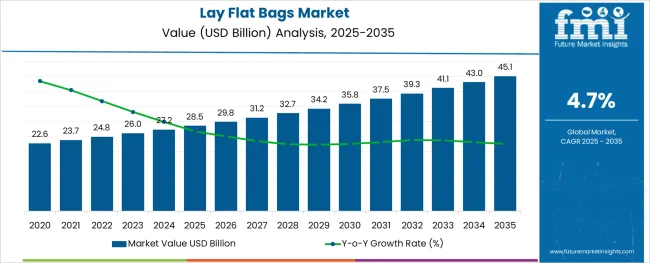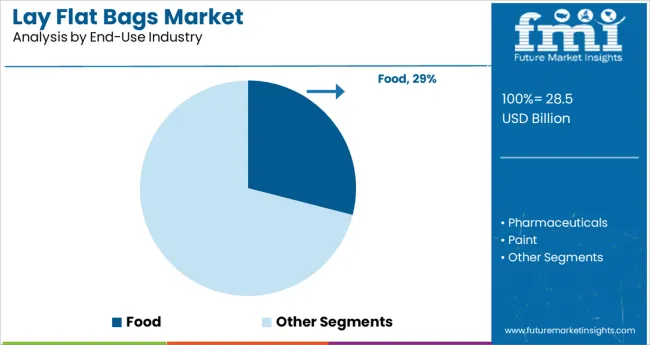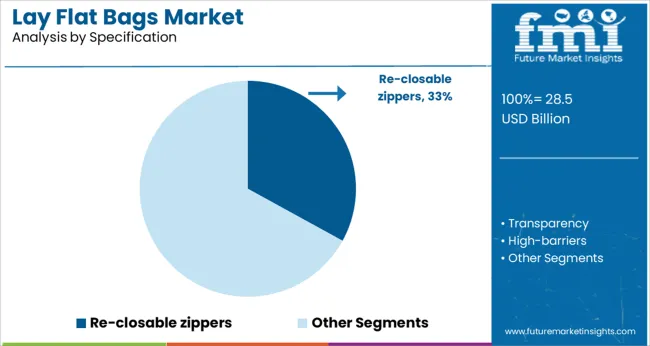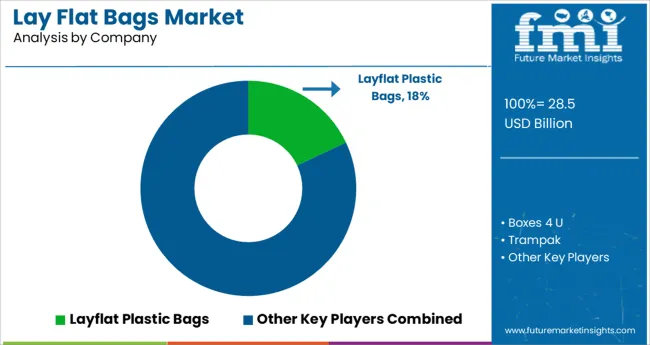The Lay Flat Bags Market is estimated to be valued at USD 28.5 billion in 2025 and is projected to reach USD 45.1 billion by 2035, registering a compound annual growth rate (CAGR) of 4.7% over the forecast period.

The lay flat bags market is experiencing steady expansion, driven by increased demand for flexible, lightweight, and cost-efficient packaging formats across various industries. Lay flat bags are being widely adopted due to their adaptability in both manual and automated packaging lines, along with their ability to reduce material waste and optimize shelf presence.
The rise of sustainable packaging practices and the growth of e-commerce and food delivery services are further accelerating their demand. Manufacturers are focusing on improving barrier properties, incorporating recyclable films, and adding functional features such as resealable closures to enhance product value and consumer convenience.
Regulatory pressure on single-use plastics and heightened awareness of food safety and freshness are influencing innovation in bag design and materials.
As brand owners seek packaging solutions that balance performance, environmental impact, and consumer experience, lay flat bags continue to gain traction in both retail and institutional settings.
The market is segmented by End-Use Industry and Specification and region. By End-Use Industry, the market is divided into Food, Pharmaceuticals, Paint, Frozen, Confectionary, Canned Foods, and Personal Care.
In terms of Specification, the market is classified into Re-closable zippers, Transparency, High-barriers, and Easy-spouts. Regionally, the market is classified into North America, Latin America, Western Europe, Eastern Europe, Balkan & Baltic Countries, Russia & Belarus, Central Asia, East Asia, South Asia & Pacific, and the Middle East & Africa.
The market is segmented by End-Use Industry and Specification and region. By End-Use Industry, the market is divided into Food, Pharmaceuticals, Paint, Frozen, Confectionary, Canned Foods, and Personal Care. In terms of Specification, the market is classified into Re-closable zippers, Transparency, High-barriers, and Easy-spouts.
Regionally, the market is classified into North America, Latin America, Western Europe, Eastern Europe, Balkan & Baltic Countries, Russia & Belarus, Central Asia, East Asia, South Asia & Pacific, and the Middle East & Africa.

The food industry is projected to hold a 29.0% revenue share in the lay flat bags market in 2025, making it the largest end-use segment. This growth is being supported by the increasing demand for packaging solutions that preserve freshness, extend shelf life, and provide convenience for both consumers and retailers.
Lay flat bags are particularly suited for dry foods, snacks, produce, and frozen goods due to their space-saving design and compatibility with automated filling systems. Their ability to be heat-sealed or integrated with easy-open features enhances their usability in high-volume packaging operations. The segment’s growth is also influenced by strict food safety regulations and rising consumer preference for transparent, resealable, and portion-controlled packaging.
As food brands expand globally and invest in efficient, compliant packaging formats, the adoption of lay flat bags within the food industry is expected to remain strong.

Re-closable zippers are anticipated to account for 33.0% of total revenue share in the lay flat bags market by 2025, making them the most popular specification feature. This leadership is driven by growing consumer demand for resealable packaging that enhances product longevity and reduces waste. Zipper closures offer the advantage of repeated use while maintaining seal integrity, making them ideal for perishable and multi-use products.
Their integration into lay flat bags supports convenience-focused packaging strategies, particularly in the food, pharmaceuticals, and pet care sectors. Re-closable features also contribute to a cleaner user experience and support brand perception by adding premium functionality without significant cost increases.
The increased investment in packaging lines capable of handling zipper integration and the rising popularity of on-the-go consumption formats are expected to further boost adoption. As sustainability and functionality continue to guide packaging decisions, re-closable zippers will remain a key differentiator in flexible packaging applications.
Lay Flat Bags are made of thin, flexible, plastic film or plastic textile for containing and storing goods such as food, chemicals, etc., and allow high volume of content. Lay Flat Bags are among the most commonly used plastic bags because they provide excellent protection for everyday use at a great price.
They are one of the easiest and most affordable ways to package any product. Lay Flat Bags offer a unique opportunity to reduce packaging weight, and product to packaging weight ratio while separating from traditional rigid alternatives like glass jars and metal cans regarding on-the-shelf appearance and consumer convenience.
The premade pouch packaging of Lay Flat Bags can be efficiently filled and closed utilizing the system of premade spouted pouches, caps and filling lines. Other features offered by Lay Flat Bags are; an easy-to-open flip-cap, a built-in tamper-evident pull ring, and an anti-spill and valve that dispenses contents on being squeezed.
The customizable valves provide clean product cutoff as well as controlled drip-free dispensing and offer maximum functionality for the consumer. In the coming years, market for Lay Flat Bags is expected to grow considerably, across the globe.
One of the major factors driving the market for Lay Flat Bags is the increasing demand from food manufacturers, such as meeting the FDA and USDA specifications for food contact and are made from low-density polyethene. These modifications are in high demand in the market since the consumer is more driven towards quick and safe intake of food ingredients, which ultimately aids in driving the Lay Flat Bags market.
For instance, the growing frozen food demand due to ease of storage indirectly drives the global Lay Flat Bags market. The Lay Flat Bags are regarded as safe by authorities, which has a positive impact on the sale of Lay Flat Bags.
The various factors that can restrain the market of Lay Flat Bags are, their make from plastic and decomposition time (which is centuries). Use of plastic bags is legislated by authorities, which also impacts the market for lay flat bags.
The global Lay Flat Bags market is divided into seven regions, namely North America, Latin America, Asia Pacific excluding Japan (APEJ), Western Europe, Eastern Europe, Japan and the Middle East and Africa (MEA). Globally, the food industry is performing in an evolving manner where food manufacturers and suppliers are developing and working closely to meets the variety of demands from consumers.
The Lay Flat Bags market in North America is in its growing phase. With the increasing disposable income and consumerism, Asia Pacific and the Middle East region stand ahead regarding the demand for vacuum thermoformed trays.
As a result Lay Flat Bags market will witness a significant rise in CAGR through the forecasted period through our forecasted period. The APEJ Lay Flat Bags market is expected to grow at significant CAGR during the forecast period, due to the growing end-use industry such as pharmaceutical food and personal care.
Europe and North America will also witness a steady but slower growth through the forecasted period. The consumer's trends are changing in the region which is influenced by the growing retailers generating the attractive and likewise innovative sale formats.

The prominent players in the Lay Flat Bags market are:
The research report presents a comprehensive assessment of the market and contains thoughtful insights, facts, historical data, and statistically supported and industry-validated market data. It also contains projections using a suitable set of assumptions and methodologies. The research report provides analysis and information according to categories such as market segments, geographies, types, technology and applications.

The report is a compilation of first-hand information, qualitative and quantitative assessment by industry analysts, inputs from industry experts and industry participants across the value chain.
The report provides in-depth analysis of parent market trends, macro-economic indicators and governing factors along with market attractiveness as per segments. The report also maps the qualitative impact of various market factors on market segments and geographies.
The retailers’ now-a-days keeps first-hand knowledge on purchase habits of the consumers which they transmit to the manufacturers in the supply chain. This information that is generated is transferred from producer to manufacturer which causes the demand for Lay Flat Bags since it is a packaging material for manufactures.
Thus, the Lay Flat Bags manufacturer has to plan their business through consumer feedback and responses, the change in the eating habits and penetration of modernizing food products such as fast food, demand for technology, etc.
The global lay flat bags market is estimated to be valued at USD 28.5 billion in 2025.
It is projected to reach USD 45.1 billion by 2035.
The market is expected to grow at a 4.7% CAGR between 2025 and 2035.
The key product types are food, pharmaceuticals, paint, frozen, confectionary, canned foods and personal care.
re-closable zippers segment is expected to dominate with a 33.0% industry share in 2025.






Full Research Suite comprises of:
Market outlook & trends analysis
Interviews & case studies
Strategic recommendations
Vendor profiles & capabilities analysis
5-year forecasts
8 regions and 60+ country-level data splits
Market segment data splits
12 months of continuous data updates
DELIVERED AS:
PDF EXCEL ONLINE
Layer Palletizers Market Size and Share Forecast Outlook 2025 to 2035
Layer Pads Market from 2025 to 2035
Clay Coated Recycled Boxboard Market Size and Share Forecast Outlook 2025 to 2035
Clay Coated Paper Market Size and Share Forecast Outlook 2025 to 2035
Clay Based Construction Products Market Size and Share Forecast Outlook 2025 to 2035
Clay Desiccant Bag Market
3-Layer Seam Tapes Market Size and Share Forecast Outlook 2025 to 2035
Inlay Paper Market Growth – Demand, Innovations & Outlook 2025 to 2035
Malaysia Tourism Market Analysis - Size, Share & Forecast 2025 to 2035
Relay Sockets Market
Display Material Market Size and Share Forecast Outlook 2025 to 2035
Display Packaging Market Size and Share Forecast Outlook 2025 to 2035
Display Panel Market Size and Share Forecast Outlook 2025 to 2035
Himalaya Vacations Tourism Market Size and Share Forecast Outlook 2025 to 2035
Display Pallets Market Size and Share Forecast Outlook 2025 to 2035
Himalayan Salt Market Analysis - Size, Share, and Forecast Outlook 2025 to 2035
Display Controllers Market by Type, Application, and Region-Forecast through 2035
Display Drivers Market Growth – Size, Demand & Forecast 2025 to 2035
Displays Market Insights – Growth, Demand & Forecast 2025 to 2035
Cosplay Clothing Market Trends - Growth & Forecast to 2025 to 2035

Thank you!
You will receive an email from our Business Development Manager. Please be sure to check your SPAM/JUNK folder too.
Chat With
MaRIA